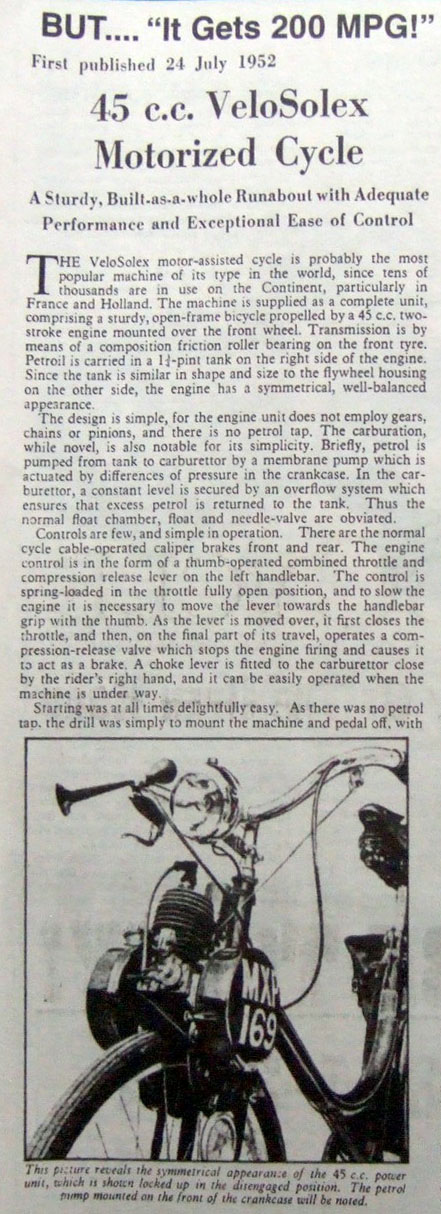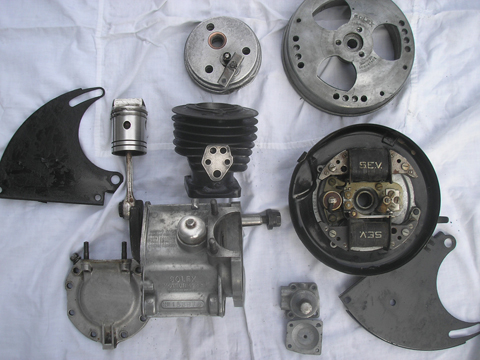

RIDING A NEW SOLEX 45 FROM LONDON TO BRIGHTON
Motorcycling Magazine obtains First-hand Impressions of the Velo-Solex motorized bicycle, which is to be produced in this country by Solex (Cycles), Ltd, 223-231, Marylebone Road, N.W.1
A sunny Wednesday afternoon saw the Velo-Solex setting off from Henly Hall, the depot of the London Distributors. The remarkable degree of silence achieved was at once noticeable, and at times it was difficult to hear whether or not the engine was running. A chance to test the model’s behaviour in London traffic was afforded almost at once, the little machine sliding effortlessly through four consecutive Oxford Street traffic jams. The steering was positive and light in operation, probably due to the well-known propensity of front wheel drive for pulling the machine in the required direction.
At 5 p.m, just 1 3/4 hours after leaving Henly Hall, a stop for refreshments was made at a Coulsdon pull-up café.
Here the VelosSolex attracted considerable attention from the drivers of various heavy lorries, who displayed interest in the potentialities of the marque. On the road again after 15-minute halt, and a few miles farther south the writer overtook a homing pedal-cyclist.
“That’s a natty gadget !” he claimed. “What’ll it do?”.
“About 16 m.p.h.on the level.”
“What! – without pedaling? How much does it cost?”queried the cyclist.
The information that the price, including purchase tax is £48 was given, and, as one of the lesser spurs of the North Downs loomed up, the cyclists dropped behind, while the Velo-Solex chuffed up the slope, a few revolutions of the pedals near the crest sufficing to keep up the speed.
The light was falling at Sam’s Half-way House, near Horley, and the Sussex border was reached by dusk. Crawley’s quiet streets were left behind and the Velo-Solex commenced the long climb into Pease Pottage. Here early pedal assistance was given, but it was possible to sit at ease on the sprung saddle, with only one hand on the bars, while surmounting the hill. A relatively level strech led to Handcross Hill necessitated the rider’s assistance, after which occasional pedalling was called for in the undulating Wealden country. The passage through the South Downs to Pyecombe where the model passed a cyclist pushing his mount when at only a third of the way up the rise was the only part of the journey where really vigorous pedalling was necessarily resorted to.
At Preston Park an escort of young cyclists on sports machines, firing questions, admiring the layout, and commenting on the abnormal silence of the engine, drew alongside. The clock of St.Peter’s indicated 8.15 p.m., as the Velo-Solex passed, making the time for the 55 miles 4 hrs.40 mins.
This average speed of 11 3/4 m.p.h. would be probably be equalled by a good touring cyclist. If so, then the markers of the machine have fullfilled their avowed intent to provide a pedal cycle “with the work cut out”. A quick check showed the petrol tank to be almost empty, which meant that, with a fuel consumption of 205.5 m.p.g., the petrol for the trip had cost 6d.!
The following Sunday was spent in testing still further the hill-climbing capalities of this fascinating machine little machine, and in trying by fair means and foul to induce roller slip. King George V Avenue in Hove a steep half-mile ascent up which even the young and energic cyclists usually push was ridden non-stop, albeit by dint of hard pedalling. The only hill upon which the model failed was a short, steep climb in the same vicinity.
Several muddy, unsurfaced lanes were traversed and even ill-treatment resorted to in the process. By letting go the decompressor too suddenly when starting the rear wheel was made to rise clear of the ground, yet no trace of slip between the carborundum-faced roller and the tyre could be seen.
– Motorcycling Magazine, 1951
The Velosolex was France’s first postwar high production cyclemotor. It went on to dominate sales worldwide. It was not necessarily the best-designed – for example, the company did not introduce a clutch until 1958 – but excellent marketing and an efficient sales and distribution network ensured its place in motoring history.
The first model used ‘650’ size wheels; the example featured here is identical except for using ‘600’ size (24″) wheels.
1951 VELOSOLEX 45
‘600’ Wheels
New Tyres and Tubes – 600 x 50B (24″ x 1 1/2 x 2 moped tyres – NOT compatible with bicycle tyre sizes)
New MOT
Restored and Ready to Ride
Serial No 158975
French Terry Saddle
RARE ACCESSORY: Cyclemotor Trailer Hitch
(Now sold)

Ownership of a 62-year-old cyclemotor is a wonderful way to tap into times past and learn about the postwar period.
Blokes no longer have to hide in the potting shed of an evening with their roll-ups tinkering with their motorcycle.
Because a Velosolex is like a family pet.
Taking it to steam rallies, summer fetes and shows becomes something the whole family can enjoy.
And, hopefully, younger members of the family can learn some basic maintenance skills (easy with a simple machine like this)
…and become the vintage enthusiasts of the future.

The Solex 45 is less practical to use than the later, more common models. It has no clutch so, when you stop at traffic lights, you need to press the lever above the engine to disengage it from the wheel. You may need to pedal off again and restart the engine. So why is this early model so sought-after?
It’s not just the fact that it’s historically more important. It is much more beautiful. Whereas British cyclemotors were quaint and German models were efficient, The French added those vital French ingredients to everything they made …beauty and style.
The frames of the later Velosolexes were angular and boxy. Only the Solex 45 featured the flowing ‘swan-neck’ styling of the frame’s backbone.
So, if you only want functionality, buy a Velosolex 3800 with a clutch; you might find one at half the price.
But if aesthetics is the two-stroke that fuels your heart…

This particular machine is from my private collection. It was restored for me in 2008 by a French friend who is a Solex specialist. You can see photos further down the page of its engine restoration.
I recently fitted new tyres and tubes and had it MOT tested.
There are no registration papers, so if the purchaser is in Great Britain, you will need to register it yourself.
The only negative thing about it this machine is a cracked and repaired lens on the front light (close-up further down the page).
The centre stand is a bit wobbly (like most of them).
It’s not a concours vehicle. It has been touched up here and there, and overall impression is very good.
It is a machine you can be proud of.
I sell my vintage machines worldwide, and will charge £250 to dispatch this treasure anywhere in the world.
Obviously oil/petrol will be drained. Dismantling and packing is free.



SHORT VIDEO of SOLEX 45 ENGINE RUNNING
http://www.youtube.com/watch?v=z5xCiSR2O8s
PLEASE CLICK HERE


RARE ACCESSORY: Cyclemotor Trailer Hitch

…Well, the photo below certainly illustrates how times have changed!

After the War, fulgars and remorques were all the rage in France.

In postwar France and England we had to make do with small single-wheel trailers behind our bikes and scooters to carry our luggage (or children!)
But in the USA a motorcycle trailer would be big enough transport 20 ground-crew around the airport…

If you fancy a trailer to add to this Solex 45 for an interesting display piece, you’ll often find one on ebay.



THE VELOSOLEX 45
(The first model)

As you can see from the above chart, this engine number 158975 was produced in 1951, probably around September/ October.


The Solex was exported all over the World…












HISTORY of VELOSOLEX 45, Serial No 158975
Patrick found this lovely old Solex for me near Paris, in 2008.

He left the Solex itself in its original paint, but stripped down the engine and totally restored it with new components where necessary.

Pat has restored over 200 Solexes. In fact he stopped doing them because he got bored with them after discovering British cyclemotors.

For many years, I supplied him with the British cyclemotors he craved. In exchange, he found me Velosolexes and other cyclemotors.

















Solex info thanks to – http://cyclo60.pagesperso-orange.fr/solex45-en.html











































